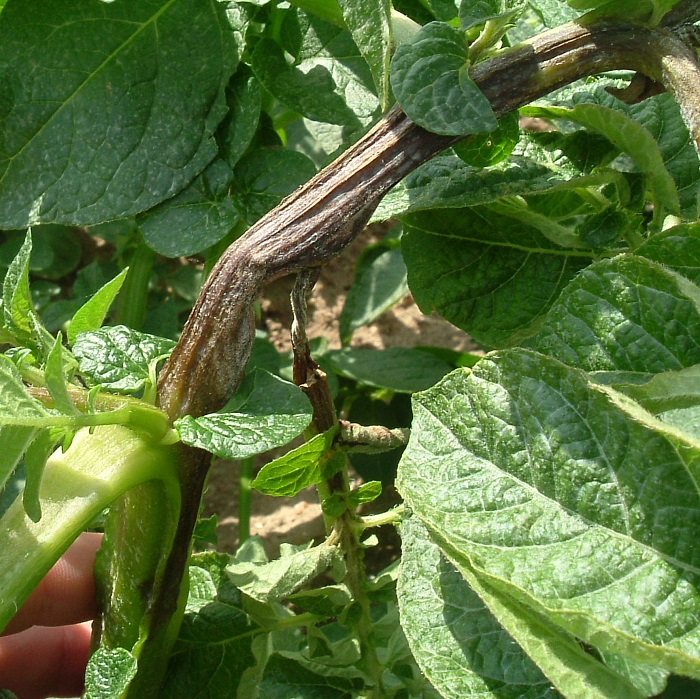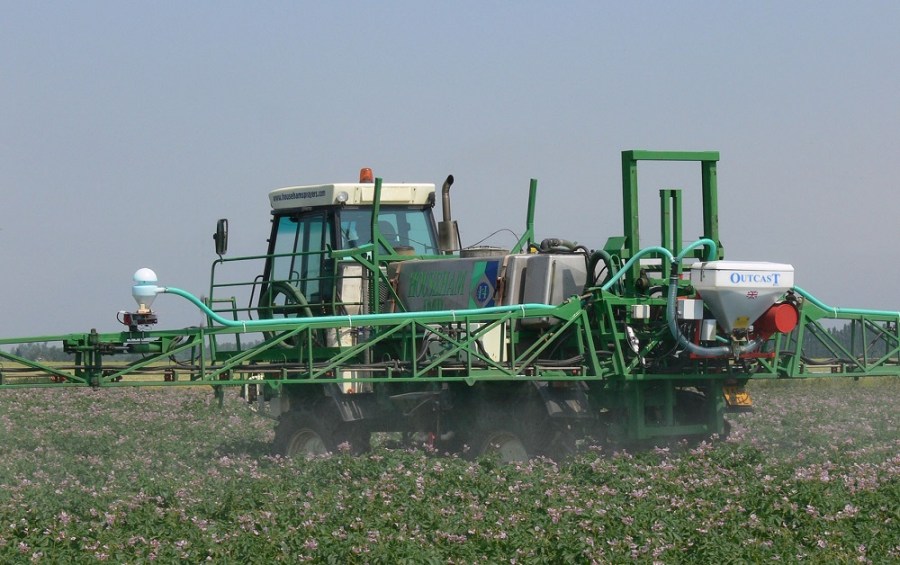With few agronomists prepared to rely on fluazinam for tuber blight control this season, a major reshuffle of the blight programme is on the cards. CPM looks at the options.
Longer spray intervals will be something new for growers to consider.
By Lucy de la Pasture
New fungicides are almost as rare as hen’s teeth these day so the approval of Zorvec Enicade (oxathiapiprolin) has come at a fortuitous time, enabling a shake-up of blight strategies to release substitutes for the much-relied upon, but now failing, fluazinam.
Zorvec’s arrival has been keenly anticipated by the potato industry having stood out in blight trials for a number of years. It gives growers the option of a truly systemic product for the first time in nearly two decades.
And this year is already stacking up to be more difficult than most, believes Dr Reuben Morris, Frontier Agriculture’s potato crop production specialist. “It’s a late planting season due to the wet ground conditions, which means there’s a strong possibility that the first blight warnings will occur much earlier in the crop’s development than normal,” he says.
Hutchinsons’ national root crop technical manager Darryl Shailes agrees. “During early season pressure, especially at the rapid growth phase when there’s a lot of foliage to cover, crops are always much more susceptible to blight. For years we’ve not had a truly systemic product to use during rapid canopy and it’s been an obvious weakness in growers’ programmes.

One of Zorvec’s strengths is knocking out stem blight early in the season.
“Phenylamide fungicides were the last to have the ability to move into new growth. Since resistance became a problem to that group of chemistry, we’ve only had blight fungicides that are translaminar. The trouble is these aren’t able to provide full protection at that crucial growth stage,” comments Darryl.
He’s keenly followed Zorvec in trials over several seasons. “There’s clear concern about the aggressive nature of blight we now face and there’s no doubt the challenges are increasing. Even in the worst blight years, when other chemistry has been severely challenged in trials, it’s been head and shoulders above everything else.”
Zorvec moves within the leaf through waxes and xylem, onto expanding shoots and leaves and into new growth. It also has no cross-resistance to existing groups of chemistry and controls all known blight strains, explains Craig Chisholm, field technical manager for Corteva Agriscience, the agricultural division of DowDuPont.
The chemistry’s capability to be protective by preventing sporangia and zoospores from germinating; curative by killing hyphae and haustoria within plant tissue; and translaminar suggests the best time to apply Zorvec is during the crop’s rapid growth stage, he says.
“Zorvec ideally suits the rapid growth phase of the crop, so it will effectively release some products for later in season, where their activity on tuber blight can replace fluazinam in the programme,” suggests Reuben.
Reuben highlights the ability Zorvec has to clear out stem blight which tends to occur during rapid canopy growth. “Because of its systemicity, if you can get Zorvec on early enough it will get into the base of the canopy and move up into the leaves more effectively than any of the other blight products currently available,” he says.

During the rapid growth phase potatoes are particularly susceptible to blight.
So how early is early enough to provide sufficient protection during the rapid canopy phase? Reuben points out that there needs to be enough foliage present to avoid wasting product by applying a large proportion to the soil. “I’m planning to apply Zorvec at T3 but there may be some people going on at T2,” he adds.
With resistance management a key concern, Zorvec is being marketed as an agronomy pack with a partner product. The new active has a 10-day spray interval but the consensus among agronomists is that a 10-day interval in the programme may not prove practical for some.
Darryl thinks there will be a mixed view on the matter. “For people who are fully irrigating every five days for scab, having a product that can be used on a 10-day interval is fantastic,” he says.
“There’ll be others who have an established seven-day regime. For them to change to a 10-day interval in the middle of a seven-day programme will take some working out from a logistical point of view.
“But when blight pressure is really high, intervals can be reduced to five days, which makes the logistics easier. Zorvec has a minimum interval of seven days, so we’ll probably see people using it in many different ways. It’ll come down to how it fits in and around other workloads and that will need to be handled by growers,” he says.
Reuben is of the opinion that the newcomer is probably best used on a seven-day interval rather than stretching it to 10 days. This is partly because aiming for seven days allows a buffer if the programme is delayed by the weather, but also because it potentially reduces any selection pressure on the new active ingredient.
“Even though Zorvec is marketed with a partner fungicide, the reality is that every other blight product that’s available needs to be applied on a seven-day interval to maintain efficacy against today’s more aggressive strains of blight. If the interval is stretched to 10-days or beyond, any blight activity is entirely reliant on the Zorvec,” he comments.
Independent potato specialist John Sarup is still weighing up the options as to how he’ll make best use of Zorvec in blight programmes, but he’s in no doubt of its credentials having seen it in trials at the very early stages of its development.
“Strategies will depend on the season but I’m leaning towards two applications in the rapid growth phase. If this can be over a three-week period then we’ll save a spray, but this may be complicated on an otherwise seven-day standard programme and irrigation that works around this,” he says.
Craig believes the flexibility the new fungicide offers is something growers will value. “Longer spray intervals will be something new for growers to consider, but we feel they’ll immediately see the benefit of added flexibility, plus the opportunity to reduce one spray pass when this 10-day strength is utilised in a block of two,” he says.
This approach of applying two back-to-back applications, starting in the rapid growth phase of the crop, helps to ensure no infection is sporulating under the crop canopy, explains Craig.
“Blight pressure over the rest of the programme will be greatly reduced and growers still have one or two Zorvec sprays in reserve if they need to apply it during the remainder of their programme,” he says.
Reuben cautions against blocking Zorvec and suggests that alternating with another mode of action is a better strategy from an anti-resistance point of view.
“We’re now seeing new blight strains, 37_A2 and 36_A2, which have been imported from Europe where it’s common practice to use blocked programmes. I believe it’s preferable to apply Zorvec twice during rapid canopy development but to use a different product between sprays,” he advises.
“This season has highlighted the fact that the more aggressive strains of blight have a propensity to cause tuber blight, with testing at James Hutton Institute revealing much of the tuber blight has been due to 6_A1, 37_A2, together with some instances of 36_A2,” he says.
With that in mind, his preference is a product with a degree of mobility that also has activity on tuber blight. Infinito (fluopicolide+ propamocarb) or Presidium (zoxamide+ dimethomorph) are products that have a good fit in the gap between Zorvec applications, he suggests.
“Zoxamide is a little different from the other products that have activity on tuber blight because it reduces zoospore production rather than having activity on the zoospores themselves. It suits application during rapid canopy or when a stable canopy has established.”
While accepting both alternating and blocking as relevant anti-resistance strategies, Mike Ashworth, Corteva’s fungicide product manager, justifies the company’s recommendation for blocking Zorvec applications.
“Alternation allows the pathogen to be hit regularly by different modes of action but means the exposure time for each active is longer. Products don’t just disappear at seven or 10 days, there’s a tail to their control period,” he explains.
“Blocking exposes the pathogen to one active for longer in the block but for a shorter time overall (because the ‘tail’ overlaps with the next application). Zorvec has a significant advantage in persistency of control, which is what allows the 10-day recommendation. As a result, our recommendation is to block and reduce the overall exposure time.
“Blocking also allows the key attributes of Zorvec, that position it so well at rapid growth phase, to be maximised without the possibility of a break in control due to the alternation in product choice letting control lapse,” he explains.
Strategies for tuber blight control
The increase in prevalence of the 37_A2 strain of blight means that many blight programmes will need to be redesigned this season because of its insensitivity to fluazinam, which has been the first line of defence against tuber blight for many years.
“Fluazinam has been applied as much as 10 times in a season, providing cost-effective activity on zoospores. Now we’re having to rethink and find substitute products with tuber blight activity,” says Reuben.
One of these is potentially Infinito, which can be applied four times within the blight programme, although some protocols may not allow application of propamocarb-containing products, especially late in the season, he warns.
Another alternative with tuber blight activity is Ranman (cyazofamid), which can be applied up to six times. “There’s a potential worry at the end of the season because of the silicone wetter used in Ranman, which could potentially exacerbate vascular browning,” he says, though adds he isn’t aware this has actually happened in practice.
John highlights Infinito, Ranman and Gachinko (amisulbrom) as his products of choice with strength on tuber blight. For him, there’s a potential problem where Zorvec is marketed with Gachinko as its partner in the agronomy pack.
“Both Ranman and Gachinko are in the same FRAC group and according to guidelines, only six applications are allowed in a season from this group and no more than three in sequence. So if Zorvec has been applied earlier in the season with Gachinko as its partner, this severely reduces the options for tuber blight later in the season,” he explains.
Zorvec is also marketed with Rhapsody (cymoxanil+ mancozeb) as partner product which John believes is the less restrictive option.
Mike believes John’s concerns are unfounded. “Gachinko is a QII fungicide and the market is moving towards this mode of action for late season activity against tube blight. QII fungicides can be used six times in a crop and as a block of three sprays maximum.
“Where a block of three sprays is used, at least three sprays of another mode of action must be used before using more QII chemistry. Essentially this limits the use of QII at the end of the season to three sprays in a block so as long as three or fewer Gachinko sprays have been applied, then a block of three QII sprays can be used at the end of the season,” he explains.
Another product which may prove a useful fluazinam alternative later in the season is Percos (ametoctradin+ dimethomorph), suggests Reuben, particularly where Infinito isn’t an option or moisture deficits mean there’s concern about using Ranman.
“Both ametoctradin and zoxamide gained approval at a similar time to fluazinam but the latter over-shadowed them in the market and the tuber blight activity they offer was largely ignored, even though they performed well in AHDB-Potatoes trials.
“Percos has on-label approval for tuber blight reduction so it could be a useful tank-mix partner for diquat at the end of the season,” explains Reuben.
Judging by the amount of volunteer potatoes in stubbles last autumn that were infected with blight, John believes the blight risk will never be far away.
“I fully expect 37_A2 to be found country-wide this season. More agronomists need to sign up as blight scouts to improve the picture across the country. At the moment there are still too few potato agronomists sending in samples for testing.
“We need to know the extent that these new blight strains from Europe are spreading, especially as 37_A2 and 36_A2 are associated with fungicide resistance. We also desperately need more information on the conditions that favour their development. Are they the same as for 6_A1 and 13_A2 or is their development faster or can it take place under cooler conditions,” he asks.
What’s most worrying is the aggressiveness of 37_A2, which was demonstrated in the Eurofins trials in Derbys, believes John. “Even though the trials were inoculated with 6_A1 and 13_A2, it was all 37_A2 by the end of the season. That’s a worrying finding as no one is sure where it actually came from.”




